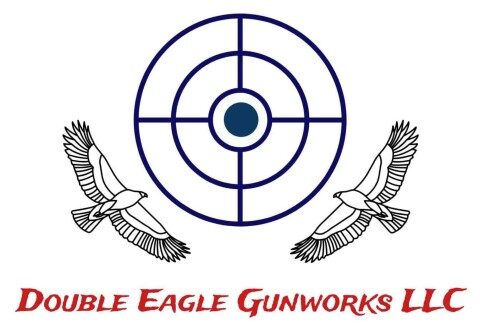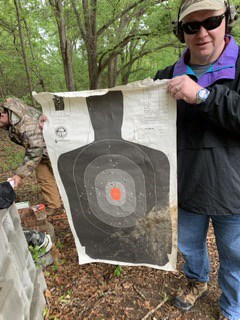It was time to get my Concealed Weapons Permit (CWP). In the state of South Carolina that means you have to shoot a gun fifty times to show that you have adequate aim and that you know how to handle the weapon safely.
Wait, FIFTY? Sounds like a lot, huh? Won’t I get tired and have a sore hand?
Yeah, you will, but you will also feel very accomplished.
When I took my CWP it was with a group of people from my church, including the pastor and his wife. That helped, because I wasn’t sitting in a room with a bunch of strangers talking about guns.
The Classwork
We spent the morning at the church learning the laws about concealed carry, the parts of a gun, the mechanics of shooting, safety rules, and what to do if you have to present your weapon in a self defense situation.
We had our fingerprints taken, watched a few videos, and had a good time learning in a group environment. Our instructor allowed us to ask questions, and of course I took advantage of that. When I learn about something as important as self defense I want the main concepts to be clear before I set foot on a range.
The Written Exam
After a thorough exposition of the concealed carry lifestyle, we took a fifty question written exam. It was a combination of multiple choice and true and false, with one fill in the blank question. The test was easy and quick.
After taking a written test we had a lunch break on our own. This allowed the facts swirling in my head a moment to assort themselves before I had to prove that I understood them enough to bear the responsibility of carrying a weapon.
The Range Qualification
We went to the instructor’s home shooting range for the qualifying portion of the test. The group was about fifteen students and the church provided half a dozen experienced shooters to help with the testing. We went to the range in groups of five or six.
Six targets were set across a field left to right, with about ten feet between one person and the next. Shooters lined up like a firing squad, equipped with eye and ear protection and focused on the target.
We followed the rules of the range:
- Follow the four cardinal rules of firearm safety:Treat all firearms as if they are always loaded. Always keep the muzzle pointed in a safe direction. Keep your finger outside the trigger guard until the weapon is pointed at the target and you have decided to fire. Always be sure of your target and what is beyond it.
- When not firing, firearms will be on the shooting bench or in a holster or case.
- Eye and ear protection are mandatory for shooters and spectators.
- All firearms in the training area will be unloaded until directed by the instructor to load.
- No horseplay in the training area.
We learned the basic range commands:
- Load: insert magazine or load cylinder with rounds
- Range is Hot: there are loaded firearms on the range
- Commence Fire: start shooting
- Cease Fire: stop shooting
- Unload: drop the magazine or unload the cylinder. Remove empty cases
- Slides Back: rack the slide to open the chamber on a semi-automatic
- Guns Down: put the firearm on the bench or in the holster
We learned what to do if you have a malfunction:
- Keep the firearm pointed down range
- Raise your hand to get the instructor’s attention
- All shooters will cease fire upon hearing the command “cease fire” and keep firearms pointed down range
Knowing the rules helped. Honestly, I wasn’t worried about what the people next to me would do. I was worried that I would veer to the left or right and take out someone next to me.
I am happy to report that no one was jeopardized by my behavior that day. Because I knew where to point the gun and why it was important to keep the muzzle in a safe direction, I stayed focused on the target.
When six people shoot at once there is a tendency for the newbies to flinch, and I did. I was the slowest shot every time because I took my time and focused very carefully for each shot. I am not usually quite THAT deliberate, but that day I was slow and methodical.
The other shooters would shoot their five bullets and then wait for me to finish number 3…4…5! They did not seem to mind, since it gave them a moment to rest after their exertions.
The requirement is to shoot fifty rounds of ammunition at a standard-sized silhouette target while wearing ear and eye protection and using a safe holster or method of carrying concealed for protection.
We lined up at 3 yards from the target and fired from the ready position, with gun held low and then brought up to fire: one round in three seconds, then two rounds in five seconds, then two more rounds in five seconds.
We moved back to five yards and shot another sequence of rounds, eventually ending up twenty yards back from the target. The test requires fifteen yards but the instructor has the option of taking you back farther.
The presentation position, drawing from a holster, is another option, but we did not have to do that the day I qualified. (When you go to a gun range, be aware that some ranges do not allow you to use the presentation method.)
Fifty hits would equal a hundred points for a perfect score. The minimum score is 35 hits, which is seventy points. I made fifty holes in the target, which would have been a perfect score, but the instructor said the dirt on my target (see the photo above) means that one of the bullets ricocheted off the ground and into the target, reducing me to a score of 98.
I thought a trick shot like that ought to earn me EXTRA points! The ricochet theory does explain why the dirt in front of the target made a big dusty cloud for a moment. Don’t tell the instructor, but I think it actually happened twice.
I qualified with my husband’s Sig P365 semi-automatic pistol. He helped me load the magazine between shots. I could do it, but it would have been like watching a turtle cross the road.
He also helped me clear a malfunction or two. One of the other helpers let me shoot his wife’s revolver after the qualifications were out of the way. I liked that much better.
I returned to the instructor’s living room to wait while the next group qualified. My heart rate was up and I felt like I had just gone on a ten-mile bicycle ride. All that focus generated adrenaline that took a while to clear.
To be fair, I took the CWP class just after having a stent inserted in my nether regions to help clear a tiny kidney stone that was not going to leave on its own. That may have affected my performance just a little.
Everyone in the class qualified. The instructor helped us finish the application to send off to the South Carolina Law Enforcement Department (SLED). Those who went to Greenville for online fingerprinting got their licenses back in a few weeks.
I did the old-style paper version, and the license arrived several months later. Incidentally, the pastor is pretty good at hitting the target, but his wife is a crack shot.
Bonus Hint: Pay special attention to the Four Cardinal Rules of Gun Safety. The life you save may be your own.


